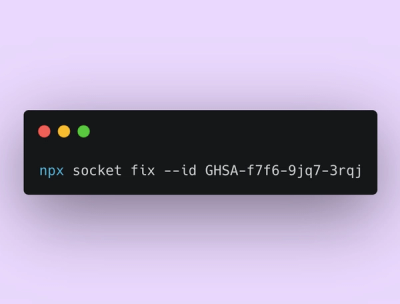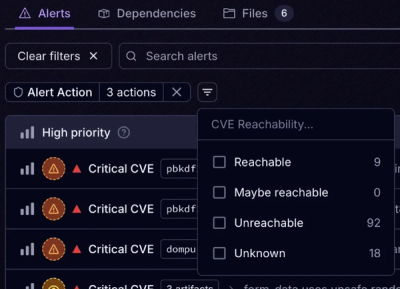
Product
Announcing Socket Fix 2.0
Socket Fix 2.0 brings targeted CVE remediation, smarter upgrade planning, and broader ecosystem support to help developers get to zero alerts.
@fulminate/deploy
Advanced tools
@fulminate/deploy is an easy to use package that allows your server to listen to hooks incoming from your VCS and execute automated code update for your projects.
REMEMBER You need to set up SSH keys yourself for your server if you use private repositories.
mkdir deploy
cd deploy
npm init -y
npm i --save @fulminate/deploy
// ./index.ts
import { deploy, server } from '@fulminate/deploy';
deploy;
console.log(`Server running on port ${server.appOptions.port}`);
When you run this script, you will get an Express application running.
Create a .fulminate directory in the root of your project and inside of it, provide the deployment options in an app.yml file:
# ./.fulminate/app.yml
# Fulminate Framework specific options
# @see https://fulminate-js.github.io/
bcrypt:
enabled: false
slackOptions:
enabled: false
channel: 'general'
apiKey: 'key'
domain: 'example.com'
port: 3000
viewOptions:
enabled: false
# Deployment options
deployOptions:
# If you disable deployment, server will throw AccessDeniedError on attending the hook route
enabled: true
# Route that will wait for VCS hook
# You need to provide your domain plus this route as your VCS hook URL
route: /deploy/api/v1/hook
# Projects living on your current server
projects:
# Project name. This value is used to provide deployment options correctly
# You need to provide this exact value at the end of your VCS hook URL
# @example https://fulminate.js/deploy/api/v1/hook/main
main:
# Git branch to checkout
branch: master
# Git repository
repository: git@github.com:fulminate-js/bootstrap.git
# Path to the project that needs to be redeployed
projectDir: ~/Documents/testing
# The name of the folder that contains the build. Defaults to `./` meaning the project itself
# will be copied to the projectDir folder. It is defined relatively to the cloned project.
buildFolderName: build
# List of scripts to be executed before copying cloned files to your project directory
# NOTE: these scripts are executed inside the temporary directory, i.e. the cloned project
beforeCopyScripts:
- npm i
- npm run build
# You can put a list of files to be copied to your project directory
filesToCopy:
# Location of the file that needs to be copied
- location: ./app.yml
# Path where the file should be put
# $PROJECT_DIR will be replaced with `projectDir` given above
savingPath: $PROJECT_DIR/.fulminate/
# List of scripts to be executed after copying the files to the project directory
# NOTE: these scripts are executed inside the project folder
scripts:
- npm i --only=production
- pm2 reload main
In the root folder of the deployer, let's create the file listed in the filesToCopy property of our app.yml.
# ./app.yml
port: 3001
Open settings of your project, create a hook to the route from the ./.fulminate/app.yml and set it to be executed on pipeline. Fulminate Deploy will only work on successful build (will be an option in a later release).
Example hook URL: https://test.com/deploy/api/v1/hook/main
beforeCopyScriptsscripts./history.json fileFAQs
Easy to use CD tool written in Node.js and TypeScript
We found that @fulminate/deploy demonstrated a not healthy version release cadence and project activity because the last version was released a year ago. It has 1 open source maintainer collaborating on the project.
Did you know?

Socket for GitHub automatically highlights issues in each pull request and monitors the health of all your open source dependencies. Discover the contents of your packages and block harmful activity before you install or update your dependencies.

Product
Socket Fix 2.0 brings targeted CVE remediation, smarter upgrade planning, and broader ecosystem support to help developers get to zero alerts.

Security News
Socket CEO Feross Aboukhadijeh joins Risky Business Weekly to unpack recent npm phishing attacks, their limited impact, and the risks if attackers get smarter.

Product
Socket’s new Tier 1 Reachability filters out up to 80% of irrelevant CVEs, so security teams can focus on the vulnerabilities that matter.